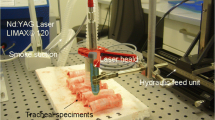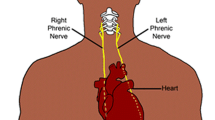Abstract
Purpose
This study was designed to evaluate the safety and tissue effects of IRE in a swine lung model.
Methods
This study was approved by the institutional animal care committee. Nine anesthetized domestic swine underwent 15 percutaneous irreversible electroporation (IRE) lesion creations (6 with bipolar and 3 with 3–4 monopolar electrodes) under fluoroscopic guidance and with pancuronium neuromuscular blockade and EKG gating. IRE electrodes were placed into the central and middle third of the right mid and lower lobes in all animals. Postprocedure PA and lateral chest radiographs were obtained to evaluate for pneumothorax. Three animals were sacrificed at 2 weeks and six at 4 weeks. Animals underwent high-resolution CT scanning and PA and lateral radiographs 1 h before sacrifice. The treated lungs were removed en bloc, perfused with formalin, and sectioned. Gross pathologic and microscopic changes after standard hematoxylin and eosin staining were analyzed within the areas of IRE lesion creation.
Results
No significant adverse events were identified. CT showed focal areas of spiculated high density ranging in greatest diameter from 1.1–2.2 cm. On gross inspection of the sectioned lung, focal areas of tan discoloration and increased density were palpated in the areas of IRE. Histological analysis revealed focal areas of diffuse alveolar damage with fibrosis and inflammatory infiltration that respected the boundaries of the interlobular septae. No pathological difference could be discerned between the 2- and 4-week time points. The bronchioles and blood vessels within the areas of IRE were intact and did not show signs of tissue injury.
Conclusion
IRE creates focal areas of diffuse alveolar damage without creating damage to the bronchioles or blood vessels. Short-term safety in a swine model appears to be satisfactory.



Similar content being viewed by others
References
Lee EW, Chen C, Prieto VE, Dry SM, Loh CT, Kee ST (2010) Advanced hepatic ablation technique for creating complete cell death: irreversible electroporation. Radiology 255:426–433
Esser AT, Smith KC, Gowrishankar TR, Weaver JC (2007) Towards solid tumor treatment by irreversible electroporation: intrinsic redistribution of fields and currents in tissue. Technol Cancer Res Treat 6:261–274
Davalos RV, Mir IL, Rubinsky B (2005) Tissue ablation with irreversible electroporation. Ann Biomed Eng 33:223–231
Bertacchini C, Margotti PM, Bergamini E, Lodi A, Ronchetti M, Cadossi R (2007) Design of an irreversible electroporation system for clinical use. Technol Cancer Res Treat 6:313–320
Edd JF, Davalos RV (2007) Mathematical modeling of irreversible electroporation for treatment planning. Technol Cancer Res Treat 6:275–286
Rabussay DP, Nanada GS, Goldfarb PM (2002) Enhancing the effectiveness of drug based cancer therapy by electroporation (electropermeabilization). Technol Cancer Res Treat 1:71–82
Goldberg SN, Dupuy DE (2001) Image-guided radiofrequency tumor ablation: challenges and opportunities part 1. J Vasc Interv Radiol 12:1021–1032
McTaggart RA, Dupuy DE (2007) Thermal ablation of lung tumors. Tech Vasc Interv Radiol 10:102–113
Miller L, Leor J, Rubinsky B (2005) Cancer cells ablation with irreversible electroporation. Technol Cancer Res Treat 4:699–705
Al-Sakere B, Andre F, Bernat C, Connault E, Opolon P et al (2007) Tumor ablation with irreversible electroporation. PLoS ONE 2:e1135
Onik G, Mikus P, Rubinsky B (2007) Irreversible electroporation: implications for prostate ablation. Technol Cancer Res Treat 4:295–300
Rubinsky B, Onik G, Mikus P (2007) Irreversible electroporation: a new modality clinical implications. Technol Cancer Res Treat 6:37–48
Allegretti JP, Panje WR (2001) Electroporation therapy for head and neck cancer including carotid artery involvement. Laryngoscope 111:52–56
Conflict of interest
Damian E. Dupuy, M.D. received grant support from Angiodynamics (Latham, NY) for this study and has received speaking honoraria from Angiodynamics.
Author information
Authors and Affiliations
Corresponding author
Rights and permissions
About this article
Cite this article
Dupuy, D.E., Aswad, B. & Ng, T. Irreversible Electroporation in a Swine Lung Model. Cardiovasc Intervent Radiol 34, 391–395 (2011). https://doi.org/10.1007/s00270-010-0091-9
Received:
Accepted:
Published:
Issue Date:
DOI: https://doi.org/10.1007/s00270-010-0091-9




